Patch angioplasty versus primary closure for carotid endarterectomy
- PMID: 35920689
- PMCID: PMC9347312
- DOI: 10.1002/14651858.CD000160.pub4
Patch angioplasty versus primary closure for carotid endarterectomy
Abstract
Background: Carotid patch angioplasty may reduce the risk of acute occlusion or long-term restenosis of the carotid artery and subsequent ischaemic stroke in people undergoing carotid endarterectomy (CEA). This is an update of a Cochrane Review originally published in 1995 and updated in 2008.
Objectives: To assess the safety and efficacy of routine or selective carotid patch angioplasty with either a venous patch or a synthetic patch compared with primary closure in people undergoing CEA. We wished to test the primary hypothesis that carotid patch angioplasty results in a lower rate of severe arterial restenosis and therefore fewer recurrent strokes and stroke-related deaths, without a considerable increase in perioperative complications.
Search methods: We searched the Cochrane Stroke Group trials register, CENTRAL, MEDLINE, Embase, two other databases, and two trial registries in September 2021.
Selection criteria: Randomised controlled trials and quasi-randomised trials comparing carotid patch angioplasty with primary closure in people undergoing CEA.
Data collection and analysis: Two review authors independently assessed eligibility and risk of bias; extracted data; and determined the certainty of evidence using the GRADE approach. Outcomes of interest included stroke, death, significant complications related to surgery, and artery restenosis or occlusion during the perioperative period (within 30 days of the operation) or during long-term follow-up.
Main results: We included 11 trials involving 2100 participants undergoing 2304 CEA operations. The quality of trials was generally poor. Follow-up varied from hospital discharge to five years. Compared with primary closure, carotid patch angioplasty may make little or no difference to reduction in risk of any stroke during the perioperative period (odds ratio (OR) 0.57, 95% confidence interval (CI) 0.31 to 1.03; P = 0.063; 8 studies, 1769 participants; very low-certainty evidence), but may lower the risk of any stroke during long-term follow-up (OR 0.49, 95% CI 0.27 to 0.90; P = 0.022; 7 studies, 1332 participants; very low-certainty evidence). In the included studies, carotid patch angioplasty resulted in a lower risk of ipsilateral stroke during the perioperative period (OR 0.31, 95% CI 0.15 to 0.63; P = 0.001; 7 studies, 1201 participants; very low-certainty evidence), and during long-term follow-up (OR 0.32, 95% CI 0.16 to 0.63; P = 0.001; 6 studies, 1141 participants; very low-certainty evidence). The intervention was associated with a reduction in the risk of any stroke or death during long-term follow-up (OR 0.59, 95% CI 0.42 to 0.84; P = 0.003; 6 studies, 1019 participants; very low-certainty evidence). In addition, the included studies suggest that carotid patch angioplasty may reduce the risk of perioperative arterial occlusion (OR 0.18, 95% CI 0.08 to 0.41; P < 0.0001; 7 studies, 1435 participants; low-certainty evidence), and may reduce the risk of restenosis during long-term follow-up (OR 0.24, 95% CI 0.17 to 0.34; P < 0.00001; 8 studies, 1719 participants; low-certainty evidence). The studies recorded very few arterial complications, including haemorrhage, infection, cranial nerve palsies and pseudo-aneurysm formation, with either patch or primary closure. We found no correlation between the use of patch angioplasty and the risk of either perioperative or long-term stroke-related death or all-cause death rates.
Authors' conclusions: Compared with primary closure, carotid patch angioplasty may reduce the risk of perioperative arterial occlusion and long-term restenosis of the operated artery. It would appear to reduce the risk of ipsilateral stroke during the perioperative and long-term period and reduce the risk of any stroke in the long-term when compared with primary closure. However, the evidence is uncertain due to the limited quality of included trials.
Copyright © 2022 The Cochrane Collaboration. Published by John Wiley & Sons, Ltd.
Conflict of interest statement
SO: none known.
TB: none known.
BS: none known.
KR: none known.
Figures
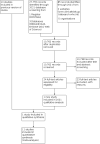
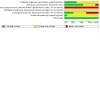
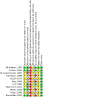
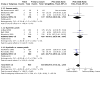
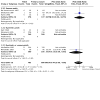
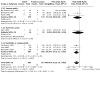
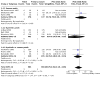
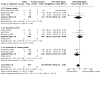
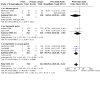
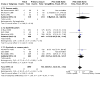
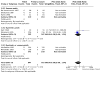
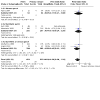
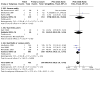
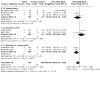
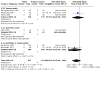
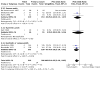
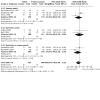
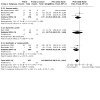
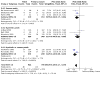
Update of
-
Patch angioplasty versus primary closure for carotid endarterectomy.Cochrane Database Syst Rev. 2009 Oct 7;2009(4):CD000160. doi: 10.1002/14651858.CD000160.pub3. Cochrane Database Syst Rev. 2009. Update in: Cochrane Database Syst Rev. 2022 Aug 3;8:CD000160. doi: 10.1002/14651858.CD000160.pub4. PMID: 19821267 Free PMC article. Updated.
Similar articles
-
Patch angioplasty versus primary closure for carotid endarterectomy.Cochrane Database Syst Rev. 2009 Oct 7;2009(4):CD000160. doi: 10.1002/14651858.CD000160.pub3. Cochrane Database Syst Rev. 2009. Update in: Cochrane Database Syst Rev. 2022 Aug 3;8:CD000160. doi: 10.1002/14651858.CD000160.pub4. PMID: 19821267 Free PMC article. Updated.
-
Patch angioplasty versus primary closure for carotid endarterectomy.Cochrane Database Syst Rev. 2004;(2):CD000160. doi: 10.1002/14651858.CD000160.pub2. Cochrane Database Syst Rev. 2004. Update in: Cochrane Database Syst Rev. 2009 Oct 07;(4):CD000160. doi: 10.1002/14651858.CD000160.pub3. PMID: 15106145 Updated.
-
Patch angioplasty versus primary closure for carotid endarterectomy.Cochrane Database Syst Rev. 2000;(2):CD000160. doi: 10.1002/14651858.CD000160. Cochrane Database Syst Rev. 2000. Update in: Cochrane Database Syst Rev. 2004;(2):CD000160. doi: 10.1002/14651858.CD000160.pub2. PMID: 10796309 Updated.
-
Patches of different types for carotid patch angioplasty.Cochrane Database Syst Rev. 2004;(2):CD000071. doi: 10.1002/14651858.CD000071.pub2. Cochrane Database Syst Rev. 2004. Update in: Cochrane Database Syst Rev. 2010 Mar 17;(3):CD000071. doi: 10.1002/14651858.CD000071.pub3. PMID: 15106141 Updated.
-
Multidisciplinary rehabilitation for older people with hip fractures.Cochrane Database Syst Rev. 2021 Nov 12;11(11):CD007125. doi: 10.1002/14651858.CD007125.pub3. Cochrane Database Syst Rev. 2021. PMID: 34766330 Free PMC article.
Cited by
-
Comparative on the effectiveness and safety of different carotid endarterectomy techniques: a single-center Retrospective Study.J Cardiothorac Surg. 2024 Jun 20;19(1):338. doi: 10.1186/s13019-024-02838-0. J Cardiothorac Surg. 2024. PMID: 38902703 Free PMC article.
-
History of Carotid Artery Reconstruction around the World and in Japan.Neurol Med Chir (Tokyo). 2023 Jul 15;63(7):283-294. doi: 10.2176/jns-nmc.2022-0362. Epub 2023 Apr 20. Neurol Med Chir (Tokyo). 2023. PMID: 37081650 Free PMC article.
-
Porcine intestinal submucosa extracellular matrix patch rupture after carotid endarterectomy.J Vasc Surg Cases Innov Tech. 2025 May 23;11(4):101854. doi: 10.1016/j.jvscit.2025.101854. eCollection 2025 Aug. J Vasc Surg Cases Innov Tech. 2025. PMID: 40612882 Free PMC article.
-
Modeling Hemodynamic Effects of the Closure Procedure of Carotid Artery Endarterectomy.Int J Numer Method Biomed Eng. 2025 May;41(5):e70048. doi: 10.1002/cnm.70048. Int J Numer Method Biomed Eng. 2025. PMID: 40396217 Free PMC article.
-
To patch or not to patch: is that the real question? The role of hemodynamics in carotid endarterectomy. Illustrative cases.J Neurosurg Case Lessons. 2025 Apr 7;9(14):CASE24840. doi: 10.3171/CASE24840. Print 2025 Apr 7. J Neurosurg Case Lessons. 2025. PMID: 40194457 Free PMC article.
References
References to studies included in this review
AbuRahma 1996 {published data only}
-
- AbuRahma AF, Khan JH, Robinson PA, Saiedy S, Short YS, Boland JP, et al. Prospective randomized trial of carotid endarterectomy with primary closure and patch angioplasty with saphenous vein, jugular vein, and polytetrafluoroethylene: perioperative (30 day) results. Journal of Vascular Surgery 1996;24:998-1007. - PubMed
-
- AbuRahma AF, Robinson PA, Mullins DA, Holt SM, Herzog TA, Mowery NT. Frequency of postoperative carotid duplex surveillance and type of closure: results from a randomized trial. Journal of Vascular Surgery 2000;32:1043-51. - PubMed
-
- AbuRahma AF, Robinson PA, Saiedy S, Kahn JH, Boland JP. Prospective randomized trial of carotid endarterectomy with primary closure and patch angioplasty with saphenous vein, jugular vein, and polytetrafluoroethylene: long-term follow-up. Journal of Vascular Surgery 1998;27(2):222-32. - PubMed
-
- AbuRahma AF, Robinson PA, Saiedy S, Richmond BK, Khan J. Prospective randomized trial of bilateral carotid endarterectomies. Stroke 1999;30:1185-9. - PubMed
Al‐Rawi 2006 {published data only}
-
- Al-Rawi PG, Turner CL, Waran V, Ng I, Kirkpatrick PJ. A randomized trial of synthetic patch versus direct primary closure in carotid endarterectomy. Neurosurgery 2006;59:822-9. - PubMed
De Vleeschauwer 1987 {published and unpublished data}
-
- De Vleeschauwer P, Wirthle W, Holler L, Krause E, Horsch S. Is venous patch grafting after carotid endarterectomy able to reduce the rate of restenosis? Prospective randomized pilot study with stratification. Acta Chirurgica Belgica 1987;87:242-6. - PubMed
Eikelboom 1988 {published and unpublished data}
-
- De Letter JA, Moll FL, Welten RJ, Eikelboom BC, Ackerstaff RG, Vermeulen FE, et al. Benefits of carotid patching: a prospective randomized study with long-term follow-up. Annals of Vascular Surgery 1994;8:54-8. - PubMed
-
- Eikelboom BC, Ackerstaff RG, Hoeneveld H, Ludwig JW, Teeuwen C, Vermeulen FE, et al. Benefits of carotid patching: a randomized study. Journal of Vascular Surgery 1988;7:240-7. - PubMed
İyigün 2019 {published data only}
-
- İyigün T, Kyaruzi M, Timur B, İyigün M, Aydın Ü. Our midterm restenosis results using patch angioplasty closure versus primary closure in patients undergoing carotid endarterectomy: a comparative study. Turkish Journal of Vascular Surgery 2019;28(1):19-23.
Katz 1994 {published and unpublished data}
-
- Katz D, Snyder SO, Gandhi RH, Wheeler JR, Gregory RT, Gayle RG, et al. Long-term follow up for recurrent stenosis: a prospective randomized study of expanded polytetrafluoroethylene patch angioplasty versus primary closure after carotid endarterectomy. Journal of Vascular Surgery 1994;19:198-205. - PubMed
Lord 1989 {published and unpublished data}
-
- Lord RS, Raj TB, Stary DL, Nash PA, Graham AR, Goh KH. Comparison of saphenous vein patch, polytetrafluoroethylene patch, and direct arteriotomy closure after carotid endarterectomy. Part I: perioperative results. Journal of Vascular Surgery 1989;9:521-9. - PubMed
Mannheim 2005 {published data only}
-
- Mannheim D, Weller B, Vahadim E, Karmeli R. Carotid endarterectomy with a polyurethane patch versus primary closure: a prospective randomized study. Journal of Vascular Surgery 2005;41:403-8. - PubMed
Myers 1994 {published and unpublished data}
-
- Clagett GP, Patterson CB, Fisher Jr DF, Fry RE, Eidt JF, Humble TH, et al. Vein patch versus primary closure for carotid endarterectomy. A randomized prospective study in a selected group of patients. Journal of Vascular Surgery 1989;9:213-23. - PubMed
-
- Myers SI, Valentine RJ, Chervu A, Bowers BL, Clagett GP. Saphenous vein patch versus primary closure for carotid endarterectomy: long term assessment of a randomized prospective study. Journal of Vascular Surgery 1994;19:15-22. - PubMed
Pratesi 1986 {published data only}
-
- Pratesi C, Frullini A, Rega L, Fonda C, Matticari S, Alessi Innocenta A, et al. The follow-up after carotid TEA. In: Maurer PC, Becker HM, Heidrich H, Hoffmann G, Kriessmann A, Muller-Wiefel H, Pratorius C, editors(s). Trends and Controversies. Vol. 1. Munich: W Zuckschwerdt, 1986:313-5.
Ranaboldo 1993 {published and unpublished data}
-
- Ranaboldo CJ, Barros D'Sa AB, Bell PR, Chant AD, Perry PM, the Joint Vascular Research Group. Randomized controlled trial of patch angioplasty for carotid endarterectomy. British Journal of Surgery 1993;80:1528-30. - PubMed
References to studies excluded from this review
Gale 1988 {unpublished data only}
-
- Gale S. Carotid endarterectomy with and without vein patch: a prospective randomized study. Journal of Vascular Surgery 1988;7:240-7.
Hertzer 1987 {published and unpublished data}
Ignatenko 2019 {published data only}
-
- Ignatenko P, Novikova O, Gostev A, Starodubtsev V, Zeidlits G, Kuznetsov K, et al. Carotid endarterectomy with autoarterial remodeling of bifurcation of the common carotid artery and carotid endarterectomy with patch closure: comparison of methods. Journal of Stroke & Cerebrovascular Diseases 2019;28(3):741-50. - PubMed
Additional references
Aboyans 2018
-
- Aboyans V, Ricco JB, Bartelink ML, Björck M, Brodmann M, Cohnert T, et al. Editor’s Choice 2017 ESC Guidelines on the Diagnosis and Treatment of Peripheral Arterial Diseases, in collaboration with the European Society for Vascular Surgery (ESVS). European Journal of Vascular and Endovascular Surgery 2018;55:305-68. - PubMed
AbuRahma 1998
-
- AbuRahma AF, Robinson PA, Saiedy S, Kahn JH, Boland JP. Prospective randomized trial of carotid endarterectomy with primary closure and patch angioplasty with saphenous vein, jugular vein, and polytetrafluoroethylene: long-term follow-up. Journal of Vascular Surgery 1998;27:222-34. - PubMed
AbuRahma 1999
-
- AbuRahma AF, Robinson PA, Saiedy S, Richmond BK, Khan J. Prospective randomized trial of bilateral carotid endarterectomies. Stroke 1999;30:1185-9. - PubMed
AbuRahma 2000
-
- AbuRahma AF, Robinson PA, Mullins DA, Holt SM, Herzog TA, Mowery NT. Frequency of postoperative carotid duplex surveillance and type of closure: results from a randomized trial. Journal of Vascular Surgery 2000;32:1043-51. - PubMed
ACAS 1995
-
- Executive Committee for the Asymptomatic Carotid Atherosclerosis Study. Endarterectomy for asymptomatic carotid artery stenosis. JAMA 1995;273(18):1421-8. - PubMed
Awad 1989
-
- Awad IA, Little JR. Patch angioplasty in carotid endarterectomy. Advantages, concerns, and controversies. Stroke 1989;20:417-22. - PubMed
Barkat 2018
Bernstein 1990
Bernstein 1992
-
- Bernstein EF. Routine versus selective carotid patching. Journal of Vascular Surgery 1992;15:868-9. - PubMed
Bond 2003
Cheng 2021
-
- Cheng SF, Richards T, Gregson J, Brown MM, Borst GJ, Bonati LH. Long term restenosis rate after carotid endarterectomy: comparison of three surgical techniques and intra-operative shunt use. European Journal of Vascular and Endovascular Surgery 2021;62(4):513-21. - PubMed
Chung 2020
-
- Chung BH, Heo SH, Park YJ, Kim YW, Woo SY, Kim DI. Comparative analysis using propensity score matching analysis: primary closure versus patch angioplasty during carotid endarterectomy. Annals of Vascular Surgery 2020;62:166-72. - PubMed
Clagett 1989
-
- Clagett GP, Patterson CB, Fisher Jr DF, Fry RE, Eidt JF, Humble TH, et al. Vein patch versus primary closure for carotid endarterectomy. A randomized prospective study in a selected group of patients. Journal of Vascular Surgery 1989;9:213-23. - PubMed
Counsell 1998
Das 1985
Deeks 2001
-
- Deeks JJ, Altman DG, Bradburn MJ. Statistical methods for examining heterogeneity and combining results from several studies in meta-analysis. In: Egger M, Davey Smith G, Altman DG, editors(s). Systematic Reviews in Health Care. 2nd edition. London (UK): BMJ Books, 2001:200.
Deeks 2021
-
- Deeks JJ, Higgins JP, Altman DG, editor(s). Chapter 10: Analysing data and undertaking meta-analyses. In: Higgins JP, Thomas J, Chandler J, Cumpston M, Li T, Page MJ, Welch VA, editor(s). Cochrane Handbook for Systematic Reviews of Interventions Version 6.2 (updated February 2021). Cochrane, 2021. Available from training.cochrane.org/handbook/archive/v6.2.
De Letter 1994
-
- De Letter JA, Moll FL, Welten RJ, Eikelboom BC, Ackerstaff RG, Vermeulen FE, et al. Benefits of carotid patching: a prospective randomized study with long-term follow-up. Annals of Vascular Surgery 1994;8:54-8. - PubMed
ECST 1991
-
- European Carotid Surgery Trialists' Collaborative Group. MRC European Carotid Surgery Trial: interim results for symptomatic patients with severe (70-99%) or with mild (0-29%) carotid stenosis. Lancet 1991;337:1235-43. - PubMed
Edenfield 2019
-
- Edenfield L, Blazick E, Healey C, Hawkins R, Bloch P, Eldrup-Jorgensen J, et al. Long-term impact of the Vascular Study Group of New England carotid patch quality initiative. Journal of Vascular Surgery 2019;69(6):1801-6. - PubMed
Frericks 1998
-
- Frericks H, Kievit J, Baalen JM, Bockel JH. Carotid recurrent stenosis and risk of ipsilateral stroke: a systematic review of the literature. Stroke 1998;29:244-50. - PubMed
Girn 2008
-
- Girn HR, Dellagrammaticas D, Laughlan K, Gough MJ, on behalf of the GALA Trial Collaborators. Carotid endarterectomy: technical practices of surgeons participating in the GALA trial. European Journal of Vascular and Endovascular Surgery 2008;36:385-9. - PubMed
Golledge 1996
-
- Golledge J, Cuming R, Davies AH, Greenhalgh RM. Outcome of selective patching following carotid endarterectomy. European Journal of Vascular and Endovascular Surgery 1996;11:458-63. - PubMed
GRADEpro GDT 2015 [Computer program]
-
- GRADEpro GDT. Hamilton (ON): McMaster University, 2015 (accessed 15 January 2022).
Halliday 2004
-
- Halliday A, Mansfield A, Marro J, Peto C, Peto R, Potter J, et al. Prevention of disabling and fatal strokes by successful carotid endarterectomy in patients without recent neurological symptoms: randomised controlled trial. Lancet 2004;363:1491-502. - PubMed
Harrison 2012
Higgins 2011
Higgins 2016
-
- Higgins JP, Lasserson T, Chandler J, Tovey D, Churchill R. Standards for the conduct of new Cochrane Intervention Reviews 2016. In: Higgins JP, Lasserson T, Chandler J, Tovey D, Churchill R, editors(s). Methodological Expectations of Cochrane Intervention Reviews. London: Cochrane, 2016:Available from methods.cochrane.org/resources.
Higgins 2020
-
- Higgins JP, Savović J, Page MJ, Elbers RG, Sterne JA. Chapter 8: Assessing risk of bias in a randomized trial. In: Higgins JP, Thomas J, Chandler J, Cumpston M, Li T, Page MJ, Welch VA, editor(s). Cochrane Handbook for Systematic Reviews of Interventions Version 6.1 (updated September 2020). Cochrane, 2020. Available from training.cochrane.org/handbook/archive/v6.1.
Knudsen 1990
-
- Knudsen L, Sillesen H, Schroeder T, Hansen HJ. Eight to ten years follow-up after carotid endarterectomy: clinical evaluation and doppler examination of patients operated on between 1978–1980. European Journal of Vascular Surgery 1990;4:259-64. - PubMed
Liu 2020
-
- Liu D, Li ZL, Wang M, Wu RD, Wang JS, Wang SM, et al. Comparative analysis of patch angioplasty versus selective primary closure during carotid endarterectomy performed at a single vascular center in China. Annals of Vascular Surgery 2021;73:344-50. - PubMed
Naylor 2018
-
- Naylor AR, Ricco JB, Borst GJ, Debus S, Haro J, Halliday A, et al. Editor's Choice – Management of atherosclerotic carotid and vertebral artery disease: 2017 Clinical Practice Guidelines of the European Society for Vascular Surgery (ESVS). European Journal of Vascular and Endovascular Surgery 2018;55(1):3-81. - PubMed
Ouriel 1987
-
- Ouriel K, Green RM. Clinical and technical factors influencing recurrent carotid stenosis and occlusion after endarterectomy. Journal of Vascular Surgery 1987;5:702-6. - PubMed
Rerkasem 2009b
-
- Rerkasem K, Rothwell PM. Temporal trends in the risks of stroke and death due to endarterectomy for symptomatic carotid stenosis: an updated systematic review. European Journal of Vascular and Endovascular Surgery 2009;37:504-11. - PubMed
Rerkasem 2011
-
- Rerkasem K, Rothwell PM. Systematic review of randomized controlled trials of patch angioplasty versus primary closure and different types of patch materials during carotid endarterectomy. Asian Journal of Surgery 2011;34:32-40. - PubMed
Review Manager 2020 [Computer program]
-
- Review Manager 5 (RevMan 5). Version 5.4. Copenhagen: Nordic Cochrane Center, The Cochrane Collaboration, 2020.
Rothwell 1995
-
- Rothwell P, Warlow C. Is self-audit reliable? Lancet 1995;346:1623. - PubMed
Rothwell 2003
-
- Rothwell PM, Eliasziw M, Gutnikov SA, Fox AJ, Taylor DW, Mayberg MR, et al. Analysis of pooled data from the randomised controlled trials of endarterectomy for symptomatic carotid stenosis. Lancet 2003;361:107-16. - PubMed
Schulz 1995
-
- Schulz KF, Chalmers I, Hayes RJ, Altman DG. Empirical evidence of bias. Dimensions of methodological quality associated with estimates of treatment effects in controlled trials. JAMA 1995;273:408-12. - PubMed
Schünemann 2011
-
- Schünemann HJ, Oxman AD, Vist GE, Higgins JP, Deeks JJ, Glasziou P. Chapter 12: Interpreting results and drawing conclusions. In: Higgins JP, Green S, editor(s). Cochrane Handbook for Systematic Reviews of Interventions Version 5.1.0 (updated March 2011). The Cochrane Collaboration, 2011. Available from training.cochrane.org/handbook/archive/v5.1/.
Volteas 1994
-
- Volteas N, Labropoulos N, Leon M, Kalodiki E, Chan P, Nicolaides AN. Risk factors associated with recurrent carotid stenosis. International Angiology 1994;13:143-7. - PubMed
Zierler 1982
-
- Zierler RE, Bandyk DF, Thiele BL, Strandness Jr DE. Carotid artery stenosis following endarterectomy. Archives of Surgery 1982;117:1408-15. - PubMed
References to other published versions of this review
Bond 2004
Counsell 1996
Publication types
MeSH terms
LinkOut - more resources
Full Text Sources
Medical

